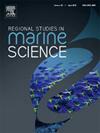Analysis water flow direction by biomarkers: A case study at the Yellow River Estuary
IF 2.1
4区 环境科学与生态学
Q3 ECOLOGY
引用次数: 0
Abstract
The hydrodynamic data in estuary is highly influenced the flow carried substances (pollutant, organic carbon, or inorganic matter) transport fate in estuary, but hard to obtain without professional hydrological monitor equipment. Here, an analysis water flow direction by biomarkers method was applied in Yellow River Estuary. Result shows pelagic bacteria community in Yellow River Estuary samples can be categorized into at least three distinct zones based on cluster analysis. In pelagic community, Flavobacteriaceae, Gammaproteobacteria, Robiginitalea, and Desulfobacterales were biomarkers from Bohai Bay, Laizhou Bay, Yellow River, and Central area of Bohai, respectively. The possible surface water flow direction of each Yellow River Estuary zones could be analyzed based on biomarkers abundance increase or decrease directions. Although without real-time hydrological data validation, utilizing biomarker tracing water flow represents a potential cost-effective and non-instrumental method for monitoring estuary water transmission. This research will greatly help the flow carried substances transport fate analysis in estuary.
利用生物标志物分析黄河河口水流方向
河口水动力数据高度影响着水流携带物质(污染物、有机碳或无机物)在河口的输送命运,但没有专业的水文监测设备很难获得。本文采用生物标志物法对黄河口水流方向进行了分析。结果表明,通过聚类分析,黄河口样品中浮游细菌群落可划分为3个不同的区系。在上层群落中,Flavobacteriaceae、Gammaproteobacteria、Robiginitalea和Desulfobacterales分别为渤海湾、莱州湾、黄河和渤海中部地区的生物标志物。根据生物标志物丰度的增减方向分析黄河口各带可能的地表水流方向。虽然没有实时水文数据验证,但利用生物标志物追踪水流代表了一种潜在的成本效益和非仪器监测河口水传输的方法。该研究对分析河口带流物质的输运命运具有重要意义。
本文章由计算机程序翻译,如有差异,请以英文原文为准。
求助全文
约1分钟内获得全文
求助全文
来源期刊

Regional Studies in Marine Science
Agricultural and Biological Sciences-Ecology, Evolution, Behavior and Systematics
CiteScore
3.90
自引率
4.80%
发文量
336
审稿时长
69 days
期刊介绍:
REGIONAL STUDIES IN MARINE SCIENCE will publish scientifically sound papers on regional aspects of maritime and marine resources in estuaries, coastal zones, continental shelf, the seas and oceans.
 求助内容:
求助内容: 应助结果提醒方式:
应助结果提醒方式:


